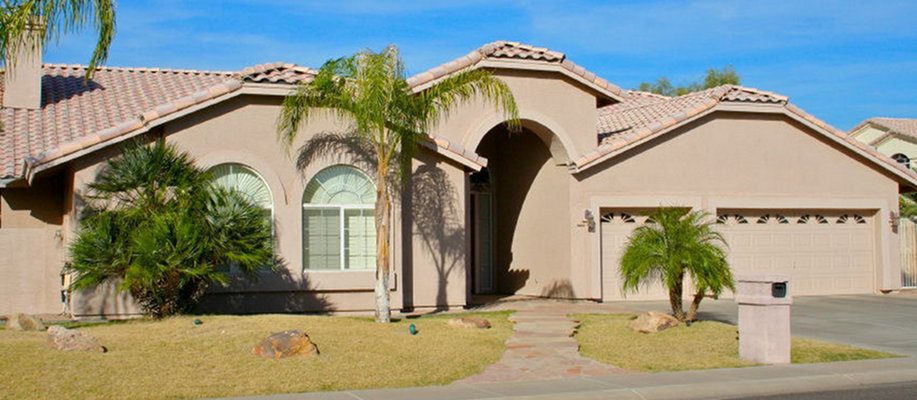My Blog
Archive for the ‘Housing Analysis’ Category
Home Values Climb 0.8 Percent In April

Maybe homes in Scottsdale are holding value better than we thought.
Between March and April of this year, home values rose 0.8 percent nationally, according to the Federal Housing Finance Agency’s Home Price Index. It’s the index’s first month-to-month improvement since May of last year.
Values are down 19 percent since peaking 4 years ago.
Private-sector data affirms the government’s report.
Tuesday, the S&P’s Case-Shiller Index also showed home values higher by 0.8 percent in April, on a monthly basis. Led by Washington, D.C. and San Francisco, 13 of the Case-Shiller’s 20 tracked markets showed improvement in April.
In March, just 2 markets did.
As a home seller , it’s nice to see reports of rising home prices after multiple months of “bad news”. However, the data may not be as rosy as it appears to be. National real estate surveys including the Home Price Index and the Case-Shiller Index are flawed for everyday buyers and sellers.
The biggest flaw is “age”. Both the Home Price Index and the Case-Shiller Index report on a near 2-month delay.
This week, the calendar turns to July. Yet, we’re still discussing housing news from April. The housing market of 60 days ago was very different from the housing market of today. Mortgage rates are different, market drivers are different, and the pool of buyers is likely different, too.
We can’t discuss today’s housing market with “April” in mind. The data is irrelevant.
Another flaw is that both reports are national in scope. Real estate, by contrast, is local.
When we cite the Home Price Index or the Case-Shiller Index, for example, and say “home values rose 0.8% in April”, we’re just giving a national average. On the local level, some markets rose by more, some rose by less, and others actually fell.
People buy homes on a specific block of a specific street in a specific neighborhood. Data for homes like that can’t be captured in a national survey.
The group that gets the most value from the Home Price Index and Case-Shiller is Wall Street and policy-makers. The indices do a fair job of reporting how housing behaves as a whole, but for individuals concerned with buying and selling homes, the best place to find real-time, accurate data is from a real estate professional.
Mark Taylor | Arizona Home Loans | Blarming | Will You Listen to Me | Arizona Short Sales | Arizona Foreclosures | Arizona FHA Loans | Arizona USDA Loans | Real Estate Websites | Arizona HUD Homes | Ariona VA Loans | Fix My Broken Credit | Arizona Mortgage | Arizona Short Sale | Power Ranch Bank Owned Homes
New Home Supplies Drop, And So Does Homebuilder Confidence
 On paper, the market for newly-built, single-family homes looks healthy.
On paper, the market for newly-built, single-family homes looks healthy.
Last month, the number of new homes sold on an annualized, seasonally-adjusted basis tallied 319,000. The May reading is the second-highest of the year, and 6 percent above the current 12-month average.
These are strong numbers in isolation. However, after accounting for the dwindling supply of new homes for sale as well, the figures look even stronger.
In May, at the current pace of sales, the complete, national inventory of new homes for sale would have been sold in just 6.2 months.
That’s the quickest pace in a year and a 3-month improvement from a year ago.
To hear it from homebuilders, though, you’d think that sales were crashing.
Homebuilder confidence slipped to a 9-month low this month; builders report slowing foot traffic; and the prospects for the next 6 months appear weak. This is not the portrait painted by HUD’s May New Home Sales report.
As a home buyer in Phoenix , this dichotomy may work to your advantage.
Falling supplies and rising demand correlate to higher home prices. Yet, builders are pessimistic for their market. Therefore, despite the economics, psychology may help buyers experience more favorable negotiations, including complimentary upgrades and other builder concessions.
If you’re a buyer in today’s market, it’s a reason to consider the new home market. There may be good value once you know where to look.
Mark Taylor | Arizona Home Loans | Blarming | Will You Listen to Me | Arizona Short Sales | Arizona Foreclosures | Arizona FHA Loans | Arizona USDA Loans | Real Estate Websites | Arizona HUD Homes | Ariona VA Loans | Fix My Broken Credit | Arizona Mortgage | Arizona Short Sale | Power Ranch Bank Owned Homes
Existing Homes Sales Slip In May
 Home resales slipped 4 percent in May, falling below the 5,000,000-unit mark on a seasonally-adjusted, annualized basis for the first time since February.
Home resales slipped 4 percent in May, falling below the 5,000,000-unit mark on a seasonally-adjusted, annualized basis for the first time since February.
April’s resales were revised lower, too.
Analysts were surprised by the figures because it runs counter to the National Association of REALTORS® monthly Pending Home Sales reports.
The association’s Pending Home Sales Index is purported to be a forward-looking indicator for the housing market because 80% of homes under contract close within 60 days and recent Pending Home Sales readings show an increase in “pending” homes.
This month’s Existing Home Sales, however, fell flat.
May’s drop in home resales wasn’t limited to a particular region or price point, either. All 4 geographic regions lag last May’s results. Five of the 6 valuation ranges fell, too.
- $0-$100,000 : +6.7 percent annual change
- $100,000-$250,000 : -21.6 percent annual change
- $250,000-$500,000 : -16.0 percent annual change
- $500,000-$750,000 : -11.0 percent annual change
- $750,000-$1,000,000 : -20.7 percent annual change
- $1,000,000 or more : -11.0 percent annual change
The Existing Home Sales report wasn’t all bad, however.
Although the months of housing stock rose to 9.3 in May, the number of homes for sale nationwide fell 1%. This suggests that there weren’t as many buyers in May as compared to April — a function of weather, jobs and the economy. Since April, the jobs market and the economy have shown steady, slow improvement and Mother Nature has been less destructive.
Home resales should rebound in June and July, therefore.
If you’re a buyer in today’s market, home supplies are higher and mortgage rates are lower. The combination makes for ample bargain-hunting. There’s excellent “deals” to be found in Scottsdale. Ask your real estate agent for help in finding them.
Mark Taylor | Arizona Home Loans | Blarming | Will You Listen to Me | Arizona Short Sales | Arizona Foreclosures | Arizona FHA Loans | Arizona USDA Loans | Real Estate Websites | Arizona HUD Homes | Ariona VA Loans | Fix My Broken Credit | Arizona Mortgage | Arizona Short Sale | Power Ranch Bank Owned Homes
Homebuilder Confidence Slips To 9-Month Low

Despite rising new home sales and an increase in building permits nationwide, home builder confidence slipped to a 9-month low in June. The monthly Housing Market Index from the National Association of Homebuilders registered 13 this month — three ticks lower than last month, and its lowest level since September 2010.
June’s 3-point drop from May is the biggest one-month move since May 2010, the month after the expiration of the federal home buyer tax credit. The retreat could signal favorable pricing for new home buyers in Scottsdale in the months ahead.
When builders get less bullish on housing, they may be more willing to negotiate for upgrades and discounts. Ultimately, this can help new home buyers buy homes at better, lower prices.
A closer look at the Housing Market Index shows why this may be true.
The Housing Market Index is not a single-reading statistic. It’s a composite; the result of 3 separate surveys, each meant to measure a specific facet of a home builder’s business. The survey questions are:
- How are market conditions for the sale of new homes today?
- How are market conditions for the sale of new homes in 6 months?
- How is prospective buyer foot traffic?
When builders reply, their responses are tallied and mapped to a scale of 1-100. Readings over 50 are considered favorable. Readings under 50 are considered unfavorable. The HMI has not been higher than 50 in more than 5 years.
In June, the HMI composite reading of 13 was anchored by falling foot traffic and reduced expectations for “future sales”. Homebuilders expect new home sales to be down through the New Year.
Therefore, if you’re a home buyer in AZ and have considered “buying new”, the time may be right for making an offer. Financing is cheap, home values are low, and builders are pessimistic — a terrific combination for today’s home buyer.
Mark Taylor | Arizona Home Loans | Blarming | Will You Listen to Me | Arizona Short Sales | Arizona Foreclosures | Arizona FHA Loans | Arizona USDA Loans | Real Estate Websites | Arizona HUD Homes | Ariona VA Loans | Fix My Broken Credit | Arizona Mortgage | Arizona Short Sale | Power Ranch Bank Owned Homes
Housing Starts Climb Unexpectedly In May
 The housing market received a jolt of good news Thursday. The Commerce Department reports that Single-Family Housing Starts improved in May.
The housing market received a jolt of good news Thursday. The Commerce Department reports that Single-Family Housing Starts improved in May.
As compared to April, last month’s Single-Family Housing Starts rose 4 percent to a seasonally-adjusted, annualized rate of 419,000 units, a figure slightly better than the 6-month average and the highest tally since January.
A “housing start” is defined as a home on which new construction has started.
In addition, Building Permits saw a boost in May, too, climbing nearly 9 percent overall. Building Permits are a gauge of future construction activity with 89 percent of permits leading to new construction within 60 days.
For several reasons, the May data surprised Wall Street analysts.
First, more homes being built suggests a healthier housing market, yet, earlier this week, the June homebuilder confidence report posted its lowest reading since September 2010.
Second, new home sales are only slightly higher than their all-time lowest annualized readings. Sales volume remains low in Scottsdale and nationwide.
And, lastly, home prices have yet to recover in full. By adding additional inventory, builders may suppress price growth through the remaining portions of 2011.
For home buyers in AZ , though, the Housing Starts data may be a signal that the market is turning. The data can be used to your advantage.
Home prices are a function of supply and demand and — based on the Housing Starts data plus the number of newly-issued Building Permits — home supply is likely to rise. Demand, on the other hand, despite low mortgage rates, may not. At least not in the short run.
As a buyer, you can use this information to your advantage. If you’re looking to buy new construction, ask your real estate agent about the current new homes supply. There are bargains to be found and May’s Housing Starts data should support low prices for at least the next few weeks.
Mark Taylor | Arizona Home Loans | Blarming | Will You Listen to Me | Arizona Short Sales | Arizona Foreclosures | Arizona FHA Loans | Arizona USDA Loans | Real Estate Websites | Arizona HUD Homes | Ariona VA Loans | Fix My Broken Credit | Arizona Mortgage | Arizona Short Sale | Power Ranch Bank Owned Homes
Monthly Foreclosure Count Drops For 16th Straight Month

Foreclosure rates are falling.
According to foreclosure-tracking firm RealtyTrac, monthly foreclosure filings fell 2 percent in May to just under 215,000 filings nationwide. A foreclosure filing is defined as any one of the following: a default notice, a scheduled auction, or a bank repossession.
On an annual basis, foreclosure counts have dropped over 16 consecutive months, dating back to January 2010.
Like all things in real estate, though, foreclosures are local. 6 states accounted for more than half of the country’s foreclosure filings in May. Those six states — California, Michigan, Arizona, Florida, Georgia and Texas — represent just 34% of the U.S. population.
But even on a per household basis, the figures remain disproportionate.
- Top 10 Foreclosure States : 1 foreclosure per 357 households, on average
- Bottom 10 Foreclosure States : 1 foreclosure per 8,764 households, on average
The nationwide foreclosure rate was 1 foreclosure per 605 households.
As a home buyer in Scottsdale , foreclosures matter. Distressed homes account for close to 40% of home resales and that’s because distressed properties often sell at steep discounts; in some markets, up to 20 percent less than a comparable, non-distressed home. Foreclosed homes can be a great “deal”, therefore, but only if you’ve done your homework.
Buying a bank-repossessed home is different from buying from “people”. The contracts and negotiation process are different, and homes are sometimes sold with defects.
If you plan to purchase a Arizona foreclosure, therefore, speak with a real estate professional first. With foreclosures, there’s a lot you can learn online, but when it comes time to submit an actual bid, you’ll want an experienced agent on your side.
Mark Taylor | Arizona Home Loans | Blarming | Will You Listen to Me | Arizona Short Sales | Arizona Foreclosures | Arizona FHA Loans | Arizona USDA Loans | Real Estate Websites | Arizona HUD Homes | Ariona VA Loans | Fix My Broken Credit | Arizona Mortgage | Arizona Short Sale | Power Ranch Bank Owned Homes
“Homes Under Contract” Plunge 12 Percent In April

Hurt by foul weather and a soft market, the Pending Home Sales Index plunged 12 percent in April.
The monthly index is published by the National Association of REALTORS® and measures the number of homes on which new contracts have been written.
It’s the association’s lone “forward-looking” report; meant to predict future, closed home sales. 80% of homes under contract close within 2 months.
Therefore, if the April Pending Home Sales Index is accurate, we should expect home sales to decline through June and July.
On a regional basis, “pending homes” varied. The Northeast Region posted growth. None others did.
- Northeast Region: +1.7% from March
- Midwest Region : -10.4% from March
- South Region : -17.2% from March
- West Region : -8.9% from March
But even regional data remains too broad to be useful to everyday buyers and sellers in the Scottsdale market. Housing is local and that means that each block, of each street, in each city has its own market and economy. Grouping 9 states into a single “region” is neither helpful nor relevant.
That said, we can’t ignore the data in its entirety.
Housing is believed to be a key component in the nation’s economic recovery. Fewer home sales will retard growth, and slower growth leads mortgage rates down.
Home Affordability hit record-highs last quarter, and should do the same in this one. Homes now sell at discounts to prior prices and mortgage financing is cheap. Buyers tend to be drawn to favorable markets such as this, and that will pressure home prices higher.
If you’re in the market for a home today, conditions look good. Talk to your real estate agent to gauge your options.
Mark Taylor | Arizona Home Loans | Blarming | Will You Listen to Me | Arizona Short Sales | Arizona Foreclosures | Arizona FHA Loans | Arizona USDA Loans | Real Estate Websites | Arizona HUD Homes | Ariona VA Loans | Fix My Broken Credit | Arizona Mortgage | Arizona Short Sale | Power Ranch Bank Owned Homes
Case-Shiller Shows Home Values Rolling Back 9 Years

The March Case-Shiller Index was released this week and it corroborates the findings of the government’s most recent Home Price Index — home values are slipping nationwide.
According to the Case-Shiller Index’s publisher, Standard & Poors, home values fell in March from the year prior.
The March report was among the worst Case-Shiller Index readings in 3 years. On a monthly basis, 18 of 20 tracked markets worsened. Only Seattle and Washington, D.C. showed improvement, rising 0.1% and 1.1%, respectively.
On an annual basis, price degradation was even worse.
Washington, D.C. is the only tracked market to post higher home values for March 2011 as compared to March 2010. The national index has now dropped to mid-2002 levels.
As a buyer in today’s market, though, you can’t take the Case-Shiller Index at face value. It’s methodology is far too flawed to be the “final word” in home prices.
The first big Case-Shiller Index flaw is its relatively small sample size. S&P positions the Case-Shiller Index as a national index but its data comes from just 20 cities total. And they’re not the 20 most populous cities, either. Notably missing from the Case-Shiller Index list are Houston (#4), Philadelphia (#5), San Antonio (#7) and San Jose (#10).
Minneapolis (#48) and Tampa (#55) are included, by contrast.
A second Case-Shiller flaw is how it measures a change in home price. Because the index throws out all sales except for “repeat sales” of the same home, the Case-Shiller Index fails to capture the “complete” U.S. market. It also specifically excludes condominiums and multi-family homes.
In some cities — such as Chicago — homes of these types can represent a large percentage of the market.
And, lastly, a third Case-Shiller Index flaw is that it’s on a 2-month delay. It’s June and we’re only now getting home data from March. Today’s market is similar — but not the same — to what buyers and sellers faced in March. The Case-Shiller Index is far less useful than real-time data of a city or neighborhood.
The Case-Shiller Index is more useful to economists and policy-makers than to everyday buyers and sellers in Mesa. For better real estate data for your particular neighborhood, ask your real estate agent for help.
A real estate agent can tell you which homes have sold in the last 7 days, and at what prices. The Case-Shiller Index cannot.
Mark Taylor | Arizona Home Loans | Blarming | Will You Listen to Me | Arizona Short Sales | Arizona Foreclosures | Arizona FHA Loans | Arizona USDA Loans | Real Estate Websites | Arizona HUD Homes | Ariona VA Loans | Fix My Broken Credit | Arizona Mortgage | Arizona Short Sale | Power Ranch Bank Owned Homes
Home Affordability Still Soaring; New Records Reached

Home affordability moved higher last quarter, buoyed by stable mortgage rates and falling home prices in AZ and nationwide. The National Association of Home Builders reports that Q1 2011 Home Opportunity Index reached an all-time high for the second straight quarter last quarter.
Nearly 3 of 4 homes sold between January-March 2011 were affordable to households earning the national median income of $64,400. It’s the 9th straight quarter in which home affordability surpassed 70 percent, and the highest reading in more than 20 years of record-keeping.
From metropolitan area-to-metropolitan area, though, affordability varied.
In the Midwest, for example, affordability was high. 7 of the 10 most affordable markets were in the Midwest, including Kokomo, Indiana, in which 98.6% of homes were affordable to median income-earning families. Indianapolis, Indiana placed second for “big city” affordability.
The most affordable “big city” last quarter was Syracuse, New York. With a 94.5% affordability rate, Syracuse ranks 8th nationally in the Home Opportunity Index. It’s the second time that Syracuse placed first in the last 4 quarters.
Meanwhile, on the opposite end of home affordability, the “Least Affordable Major City” title went to the New York-White Plains, NY-Wayne, NJ area for the 12th consecutive quarter. Just 24.1 percent of homes were affordable to households earning the area median income, down more than 1 percent from the last reading.
Regardless of where you live, remember that rising mortgage rates can levy more pain on your household budget than can rising home values. And mortgage rates are expected to rise long before home prices do.
The rankings for all 225 metro areas are available for download on the NAHB website.
Mark Taylor | Arizona Home Loans | Blarming | Will You Listen to Me | Arizona Short Sales | Arizona Foreclosures | Arizona FHA Loans | Arizona USDA Loans | Real Estate Websites | Arizona HUD Homes | Ariona VA Loans | Fix My Broken Credit | Arizona Mortgage | Arizona Short Sale | Power Ranch Bank Owned Homes
Home Price Index Shows Values Down 19 Percent From Peak
 Home values dropped for the sixth straight month in March 2011, according to the Federal Home Finance Agency’s Home Price Index. The Home Price Index is a government-sponsored home value tracker.
Home values dropped for the sixth straight month in March 2011, according to the Federal Home Finance Agency’s Home Price Index. The Home Price Index is a government-sponsored home value tracker.
The HPI report is the latest in a string of “falling home values” stories — a trend that’s troubling home sellers across Mesa and nationwide.
However, although the Home Price Index says home values are falling, that doesn’t necessarily mean that they are. Like most statistics in the housing sector, the Home Price Index is plagued by poor methodologies and a lack of timeliness.
In short, the Home Price Index is flawed. In three ways.
The first big flaw in the Home Price Index is that it only measures the values of homes with mortgages backed by Fannie Mae or Freddie Mac. Homes financed via FHA, or via other means are specifically excluded from the calculation. For today’s purchase market, that leaves more than 1 in 4 homes “uncounted” — a big percentage of the market.
Second, the Home Price Index determines home values by measuring price change from sale to subsequent sale. This eliminates new homes — a major market segment.
And, lastly, the Home Price Index reports on a 60-day delay; we’re only now seeing data from March. This two-month lag renders the HPI a trailing indicator for the housing market instead of a forward-looking one. If you’re a home buyer looking for market insight, the HPI can’t give it — it’s out-dated and out of season.
Despite its shortcomings, though, we can’t ignore the Home Price Index completely. It’s among the most thorough home valuation models available, and it’s used in public policy discussions. When the HPI says prices are down, Wall Street and Capitol Hill take notice, and that trickles down to everyday life on Main Street.
Since peaking in April 2007, the Home Price Index is off 19.1 percent.
Mark Taylor | Arizona Home Loans | Blarming | Will You Listen to Me | Arizona Short Sales | Arizona Foreclosures | Arizona FHA Loans | Arizona USDA Loans | Real Estate Websites | Arizona HUD Homes | Ariona VA Loans | Fix My Broken Credit | Arizona Mortgage | Arizona Short Sale | Power Ranch Bank Owned Homes









































